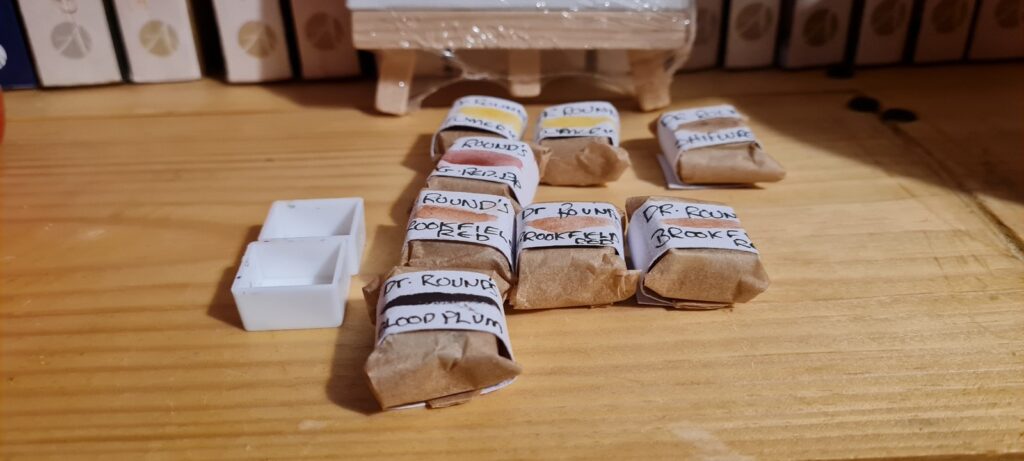Dr Round’s Bespoke Watercolours
So after the first tests with purchased pigments, I have gone up a level and foraged a few of my own and had a go an processing these as inspired by Found and Ground. Ultimately what you are doing here is getting the raw material and processing this to the finest particle size you can.
With earths and sands the best way to do this is often levigation – basically washing the material and puring off the finest suspended particles, syphoning off the water and letting this dry. With some solid raw materials – bricks and stones, I have just crushed and ground these. I foraged various materials, including slate, crumbling bricks, clay and sands.
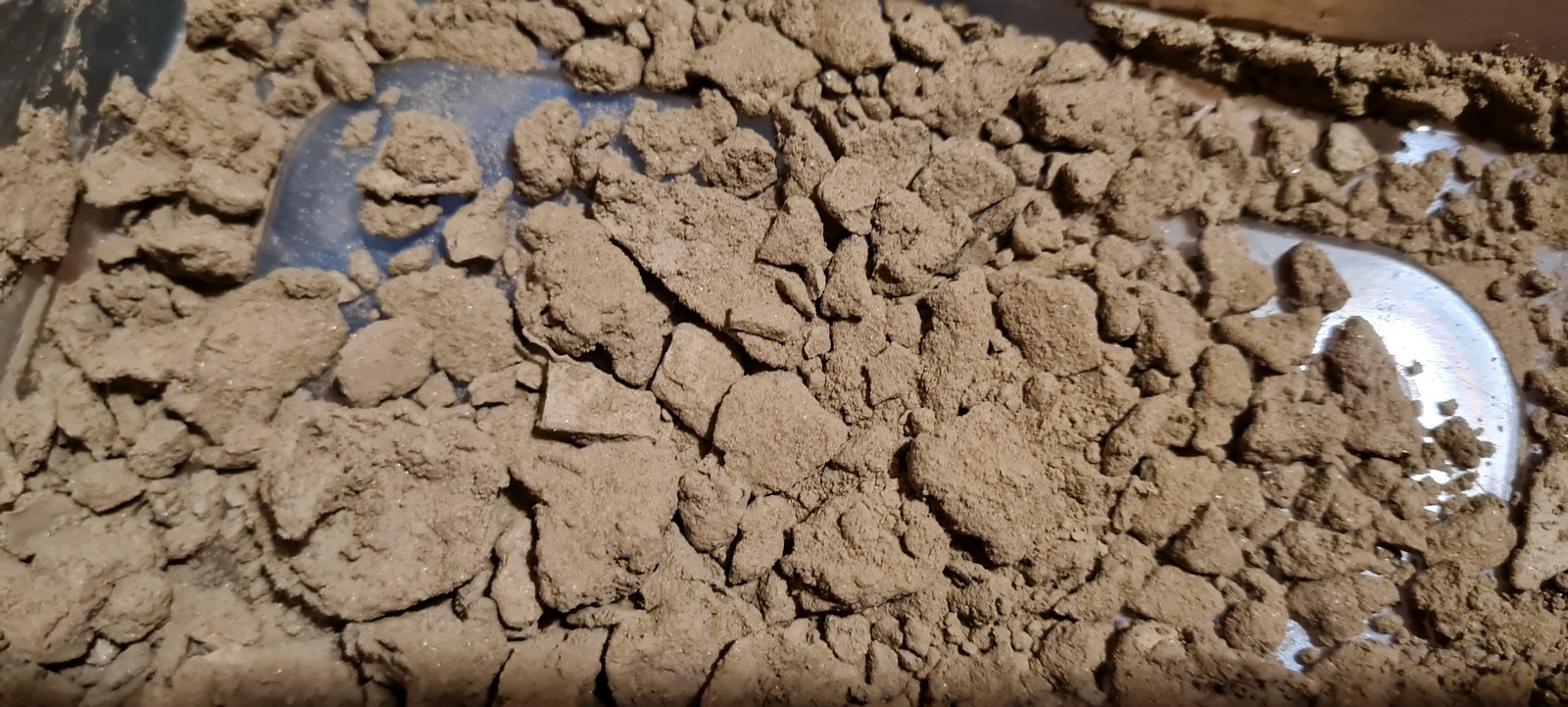
My general process is to use a larger granite morter and pestle to grind to a powder and collect this throgh a household sieve, and then repeat this process via a finer tea strainer. This is obvious nowhere close to the >50µm size of even the largest common pigments, but I am getting fine enough pigment even via just this method to get a base colour, albeit with some significant grit.
So, I present: Dr. Round’s Bespoke Watercolours, edition one1…
Shipwreck
PBr7 – Natural Brown Iron Oxide2

This is made from rust scrapings from metal parts I foraged from a small wrecked boat hull in New Holland about 7 years ago. I ground these in the Mortar and Pestle and seived them. I am really pleased with this, especially the way it stains brown with black granulation. This however has been a bugger to dry, remaining wet and really sticky for days, presumably because there is no absorbancy in the pigment to take up water. I debated whether to classify this as PBr6 or PBr7, but settled on the latter as the Iron Oxides are naturally formed rather than industrially produced.
Bentley Lane Sienna
PR102 – Natural Red Iron Oxide
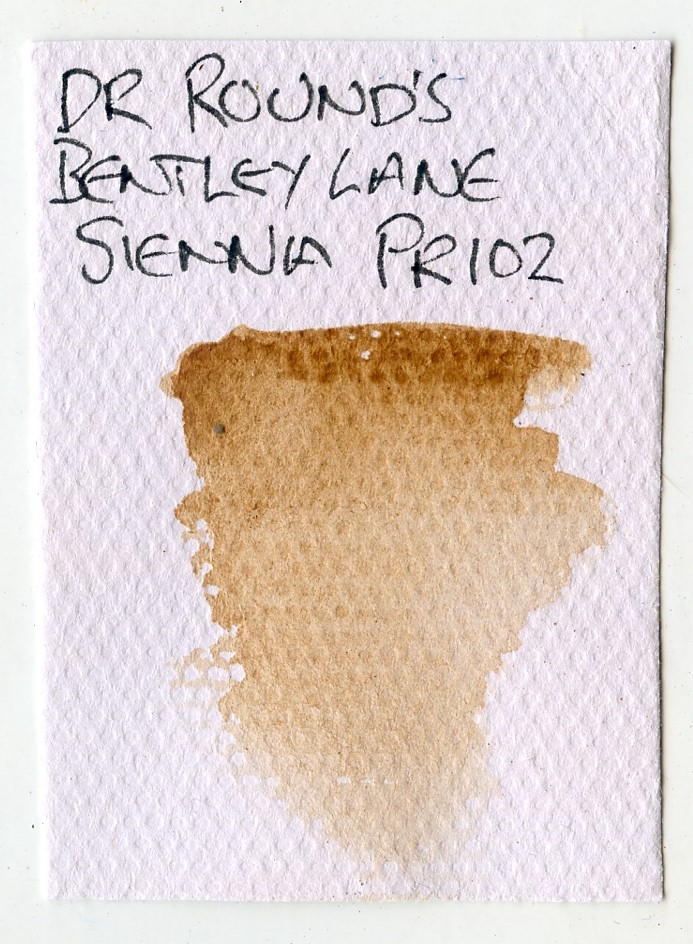
This was obtained from a pile of builder’s sand and clay from gas pipe workings at the top of my street. I washed and levigated this and poured it onto some old watercolour paper to dry. I am not sure if it was the size from the paper, or that is was really thick clay but this took a long time to dry, and when I scraped it off into a dish it set solid and had to be chipped off with a knife and re-ground. It’s made a lovely Sienna type colour which I can see being really useful.
Turmeric
NY3 – Curcumin
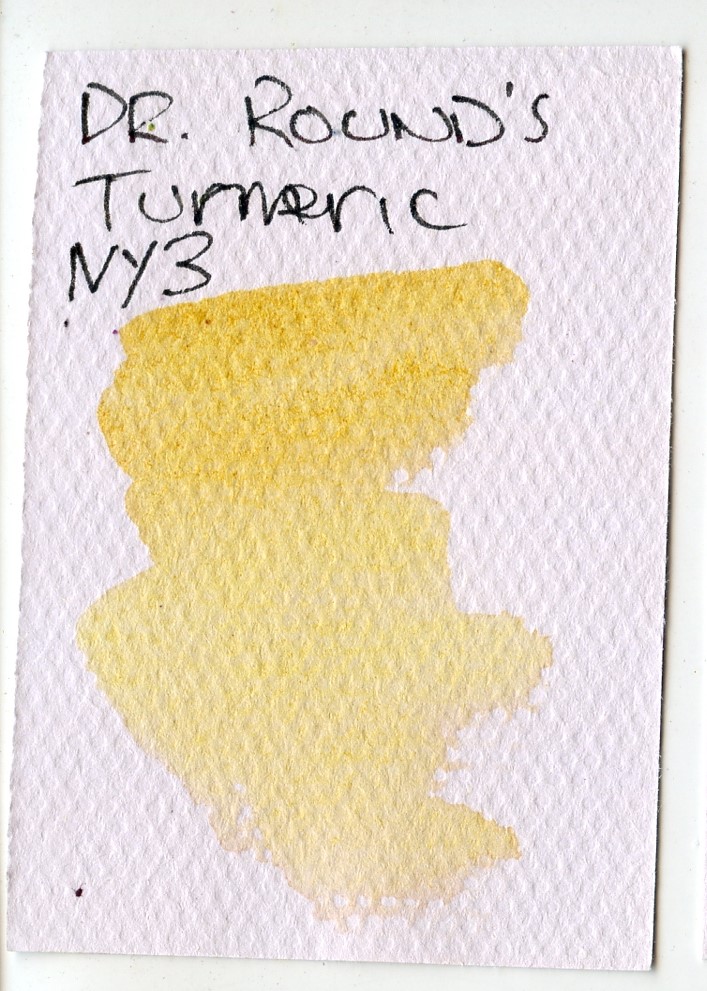
For this one, I foraged the kitchen cupboards. This has made a lovely semi-transparent staining yellow, with very slight granulation. I suspect as a plant pigment this will not be overly lightfast, but it is certainly a nice colour to play with. I was pleased that Curcumin does indeed have the Pigment Index Designation NY3.
Brookfield Red
PR101 – Synthetic Red Iron Oxide
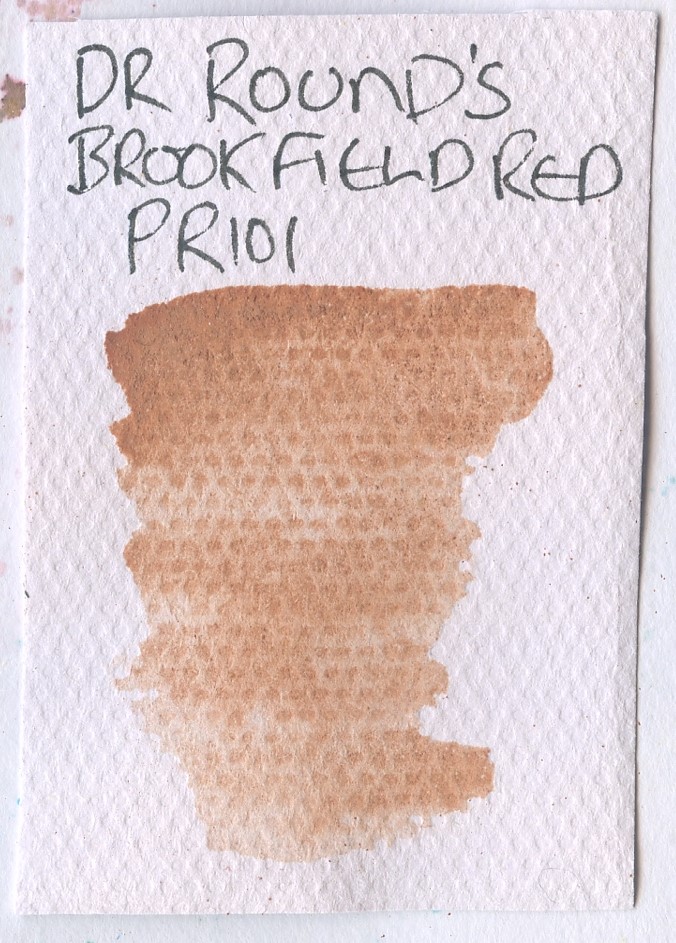
This came from some crumbling Victorian Brick which had flaked off a wall in Brookfield, a row of houses near me, blessed in location and cursed by damp due to their proximity to Meanwood Beck. I actually ended up with quite a lot of this, as I realised that the brick powder was still quite damp when I mixed it, and released this water into the paint. This meant that the first tests were very crumbly and didn’t bind well to the paper, so needing more binder and then more pigment. So I have 4 half-pans and a tube of this. My ground from the leftovers is very gritty and textural, but these do bind to the paper giving an interesting finish and a lovely muted red. I think I will find some more similar brick (there’s no shortage round industrial North Leeds) and try and pulverise enough to make a finer levigated version of this one.
Cardboard Hill Umber
PBr7 – Natural Brown Iron Oxide
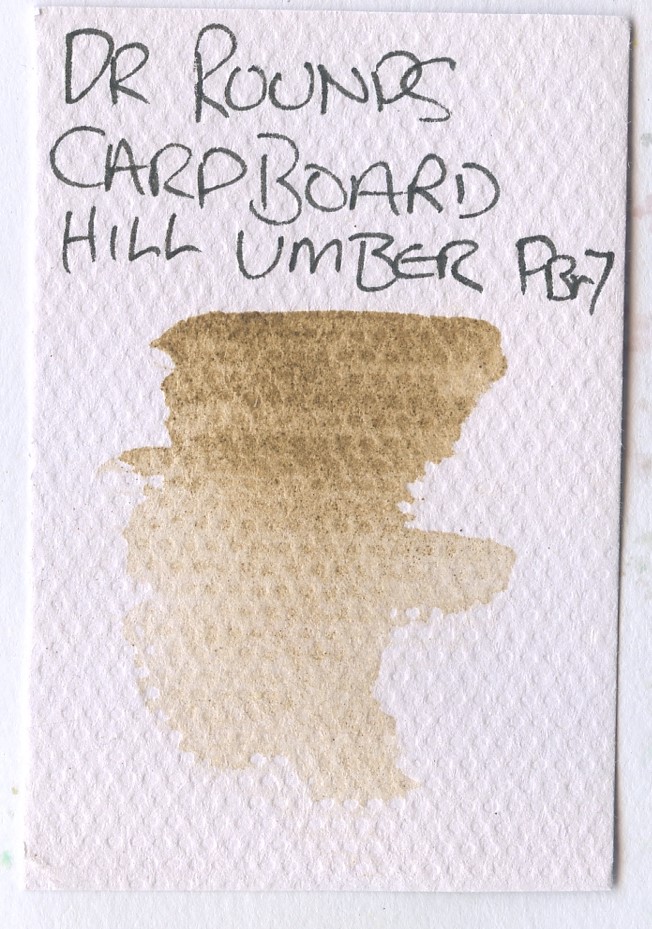
I collected a number of bags of mud and rocks from Meanwood Beck – when the beck is low you can see a lovely range of stratified clays in the bank, but with the recent horrid weather the beck was in spate and much of these were covered. This came from a small soft clay rock I found in a bag of mud from Cardboard Hill when I put it in a jar to wash (the result is in fact the pigment in the picture of drying pigment above). This was so soft it ground up very fine, and came out much darker once in the medium than the stone itself looked, with this slight greenish tinge reminiscent of an umber, hence the name I have given it.
University Yellow
PY43 – Natural Yellow Ochre
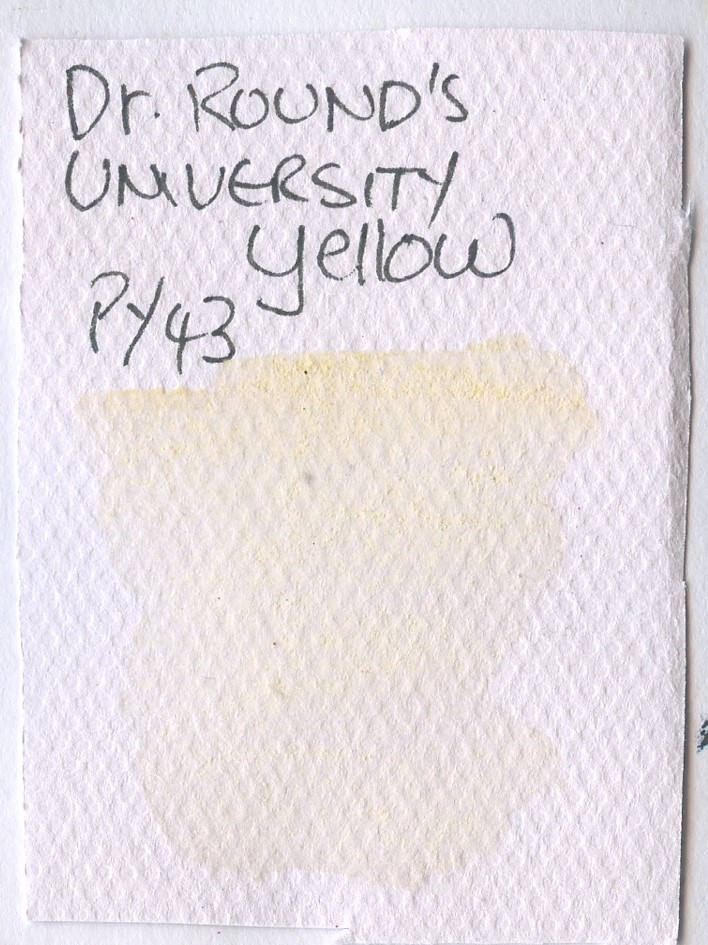
This came from lumps of pale yellow clay, such as is often used for hardcore under paving, or to fill and soak up puddles in muddy tracks. I found this randomly outside the University campus. This crushed and dried far, far paler than the rock itself; we joked that I had made Magnolia, but I kept the yellow name as it is essentially a yellow ochre.
Penmachno Purple
PBk19 – Slate3

This is one I have been looking forward to. In the quarry in Cwm Penmachno one can find the most amazing purple slate, and anyone who knows me knows this is a very special place to me. It was suprisingly hard to grind and I had to start with a hammer, and is even grittier than the Brookfield Red, but the colour and granulation has not dissapointed. This is another I would like (if I can face pulverising so much slate) to make a finer levigated pigment from, though my supplies of the genuine Penmachno Purple slate are waning.
I have really enjoyed doing this, and have a fair few bags still of collected material to process and play with. I’ll post some pictures when I have used them – with all this flurry of being a colourman, combined with Christmas, I have not managed any painting for a couple of weeks.
I’ve also, with the invention of the Dr. Round’s name, wrapped my spare half-pans in some cute little labels. It had to be done.
